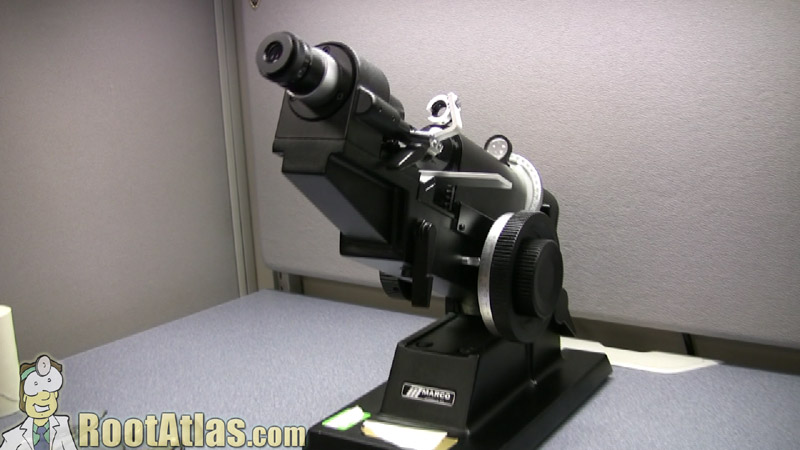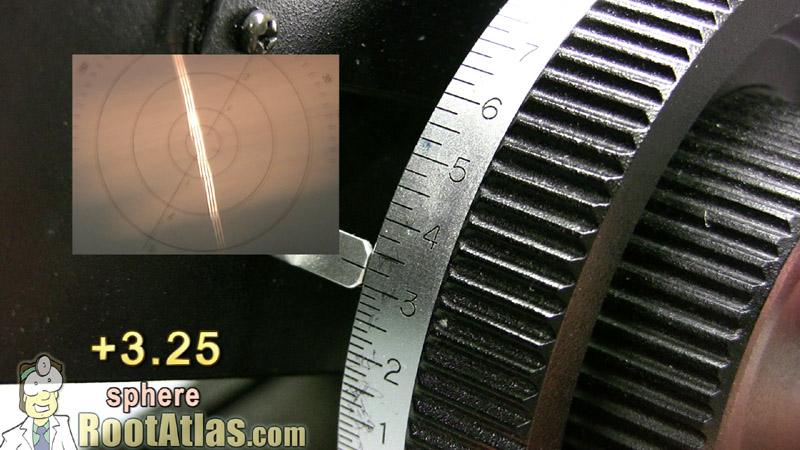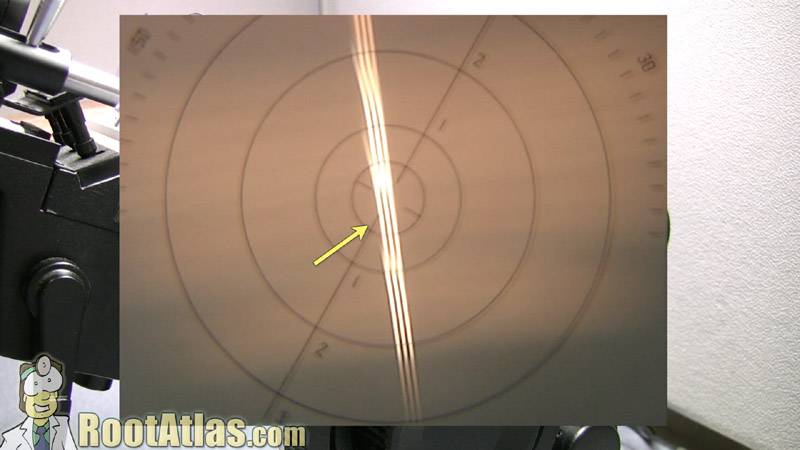Using a lensometer to check glasses (Video)
This video shows the use of a lensometer, a device used to check the prescription in glasses. This device can be tricky for the novice technician to use, as you must align the glasses well and move two dials at the same time to hone in on the prescription.
Here are the steps:
1. Place glasses on platform and secure
2. Turn axis and focus nobs so that the SMALL lines are straight and focused
Write down the number. This is your sphere.
3. Turn the focus nob until the fat lines become focused, and look at the new number on the focus nob. The DIFFERENCE from your prior sphere value is the CYLINDER value. If you changed from +1.00 to +4.00, then your cylinder is +3.00. If you changed from +1.00 to -1.50, then your cylinder is -2.50. In other words, the cylinder can be a positive or negative number, depending upon the direction you have to turn the focus nob.
4. Check the degrees on the axis dial. This is your cylinder axis.
If you want to check the bifocal add:
5. Move the glasses so that the bifocal segment is being read.
6. Turn the focus nob again until the fat lines again become focussed.
The amount of change needed to refocus the fat lines will give you your bifocal power.
Download this video
To download this video, right click on a link below and choose “Save Target/Link As…”
lensometer.wmv (13 meg, Windows video file)
lensometer.mp4 (13 meg, Ipod Video)
Thumbnails (click to enlarge photo)



Thanks for your help in refreshing my memory…video was very concise and useful…
many thnx4 your help in education plz send education video 4 my e mail
I’m glad you liked the video and thank you for commenting. Unfortunately, the video file is just too large in size to e-mail. You can download it directly, however, from the links above.
great job
thank for your help in education pls send education video 4 my email especial in slitlamp technic tk.
Thanks for the help. I,m re-entering the job the work force as an optical dispenser. This was the best.
Thanks for the help. I,m re-entering the work force as an optical dispenser. This was the best.
thx alot 4 ur help in education plz send education video 4 my e mail
thanks a lot for the information. please kindly send me in my E Mail Address all more about lensomater technique in reading the amount of prism induce in the lens. thanks
thanks alot for all the information, it refreshes my memory. please kindly send me some slit lamp information technique. thanks.
Thx so much in education, wld u plz send education video 4 my e mail. Cheers.
thanks a lot for the information.plz send some more video for minus number$ compound number on my e mail.
This flick just corrected 1 niche that i needed for perfection!
Very nice, thank you.
However, I did hear somwhere that one has to turn the glasses upwards to get the correct result for certain lense???
Went back into the wonderful field of optical again and thank-you for the refresher class on the use of the lensometer. Was very helpful. 🙂 🙂 Just hoping to remember how to check prisms. THANKS AGAIN
thanks for help in education
Great video! Are the measurements independent of the lens refractive index?
Thanks
Hey people, stop asking for junk to be sent “4 ur Email”. Learn some professionalism. Optical work isn’t done in a back alley you know.
THE ADD(BIFOCAL) POWER IS PROBALY A 2.25 ON THIS LENS. THE BIFOCAL POWER SHOULD BE CHECKED FROM THE BACK OF THE LENS, IE; FRONT VERTEX POWER FOR THE ADDED PORTION.
thanks for this information. How do you check for prism in lenses.
These videos are the God’s gift and sure Timothy Root’s gift to ophthalmic Residents. Definitely it is the bible for better eye knowledge. Thank you Timothy Root 🙂
I hope that you can make a video illustrating Keratometry Readings for calculation of intraocular lens (Non automatic keratometer) .
Thank you from Russia, Kursk state medical uniVersity
thanks for this information…how do you check for prism in lenses….
Dear Rootatlas.com,
Thank you guys so much for showing me how to use the Lensometer! I just started an optician apprenticeship, and really needed to know how to understand how to use this thing:) You guys made it super simple and easy to understand:) Thanks again!
The one basic thing missing was telling the student about focusing for either plus or minus cylinder. It would also be nice to show how to measure for prism. Maybe you could do that at some point in time. You really have nice video presentations and I really enjoy your site.
Thank you.
Hi Tim Root
Congratulations on getting the number 1 google spot for lensometer. Hope all is well and BP doesn’t crush your dream of the beach front gulf coast home in Florida.
Jake Moore
That is a great Video! This type of information can be very useful when organizing staff meetings. What a great tool for the new hire.
Great video. I’m linking to it from a new site I just started for optician apprentices. It may be useful to also show what it would look like without a cyl and axis as well as what a prism would look like. Thanks!
very concise and helpful
Tu informacion esta barbara me ayudo muchisimo a refrescar mi memoria,podrias enviarme, algun ejemplo mas con prisma y si es un multifocal.Muchisimas gracias.
laura
I appreciate the video that you have about then lensometer. Can you send me some more information about prism and the calculations on a lensometer?
its realy informative
how to check prism amount in lensometer ?
can u pls explain about the compound rx. + and – . Thanks.
This video is precise, concise and very lucid. It refreshed my memory and answered my questions spot on.
Thanks a lot.
O.Gun
Thank you for simplifying the use of the lensmeter. Is it possible for you to demostrate how to read the power of a lens in minus form.
Thank You.
Need help with prism please e-mail me prism video! Please
You got a very good website, Gladiolus I noticed it through yahoo.
very useful thanks
Thank you for explaining in video it was very helpful!
The add power was read incorrectly. The spectacles should’ve been “turned around” so that the add was read in front vertex power. On the compound hyperopic astigmatic lens you used in your example, you would’ve underestimated the add.
Very simple to understand.thanks.i couldnt download the video though.
for lensmeter i have also added few things you can read
helpfull
love this video,it helped refresh my memory.Thanks a tonne.
thanks for your usefull website it really helped me
more power
tnx alot so usful.
How did you get the video of the lensometer bars? We are trying to find a camera for ours for training purpsoes. Thanks
is there one on checking prism in a lensometer
thx a lot for training video,i never forgot this top video.plz mail it f me.thx
excelent video!! would you show us how to check prims in rx? thank you very much for your time.
thank u my dear teacher
When reading the add power you always use the three separate lines,not the skinny lines?
Thank you, useful video for new users……….
nice video but what about the lensometers that require the optician to transpose the two readings? For ex. I have the NIKON OL-7 that the first reading in a miopic astigmatic lens shows -4,75 and the second -5,25 . What sign should i put and what about the ipermetropic astigmatic lenses. they always confuse me with the transposition! PLZ HELP !
Don’t you need to read that high plus lens from the back surface to determain the add power? My experience is that the add power will read to strong if you only use the front surface.
i think when ur reading from the forcemeter always consider your cyl sign 2 b negative e.g for positive sph take the more positive subtract it from the less positive to be able to get a minus cyl
hie? can you please send me videos of how to use a lensometer via my e-mail
Alexx, the video is too big to email, but the download link is above. Just RIGHT-MOUSE click on the link, and choose “Save Target …” to save the video to your computer. Good luck.
HELPFUL
Hello Dr. Tim,
Pls when do we expect an App from you so that we could have your excellent videos on our palms.
Thanks so very much for all your high level of professional work.
Regards,
Ozone.
Thanks a million for this info please don’t forget to share any good information about this course.
Need help on using the manual lensometer for minus cylinder.
good teacher
l am one of the seles men of optical shop
l worked more then 10 years.
l know haw to use lenmeters.and haw to making classes..
and also haw chaking the the person..
but l have not any diploma .
becouse there is not and school of optician.in my country
so help me haw to get diploma of opticain
thank you my doctor
Does it make a difference for measuring ADD power if you measure the fat lines and use the diff between cup fat lines of distance to add fat lines (like u show in video), OR go until the single thin lines in focus in ADD and use diff btwn dog single one in distance and single line in add for BIFOCAL PWR (which is what I’ve always been taught). **confused**
Thank you so much for teaching us the basic about lensometer.
Tim Root Explain things easily.
If the power wheel does not read zero, re-focus the eyepiece and re-check the calibration. If the power wheel still does not read zero, the error must be compensated for on all future measurements made with the lensometer, or the lensometer needs maintenance. (Note: algebraically subtract the calibration error from the power measurement to compensate for calibration errors.) When the lens is positioned as above – where the centre of the focimeter target is over the centre of the graticule – then you are at the optical centre of the lens. Note: if there is a ground prism in the lens, despite movements of the lens up-and-down or side-to-side, the focimeter target will not be centred over the graticule – so there is no optical centre of such a lens.